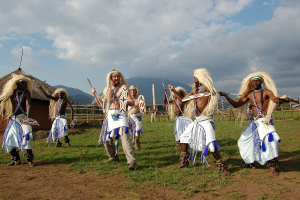
7 Days Rwanda Uganda Safari
7 Days Rwanda Uganda Safari : This safari for 7 days takes you to Rwanda and Uganda, respectively. Gorilla trekking in Volcanoes National Park and
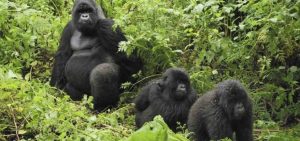
8 Days Uganda Rwanda Wildlife Safari
8 Days Uganda Rwanda Wildlife Safari: Enjoy the most memorable safari with this 8-day trip to Uganda and Rwanda that will give you the chance
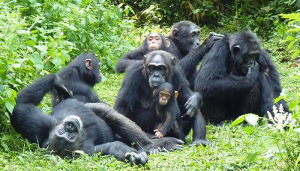
7 days Uganda gorilla and wildlife safari from Kigali
The 7 days Uganda gorilla and wildlife safari from Kigali makes for an interesting safari, which starts and ends in Kigali Rwanda, and starts and
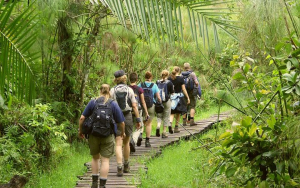
8 days Uganda Rwanda gorilla and wildlife safari
8 days Uganda Rwanda gorilla and wildlife safari : This is an enjoyable and exceptional safari that will take you from Kigali Rwanda to Entebbe Uganda,
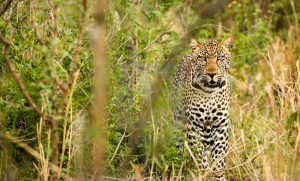
20 Days Uganda wildlife Safari Tour
20 Days Uganda wildlife Safari Tour : With this 20 days Uganda safari tour, you will be able to experience the most popular national parks
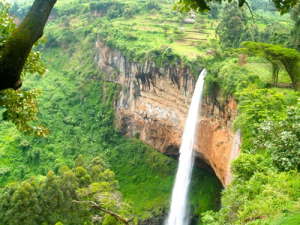
3 days Sipi falls tour
3 days Sipi falls tour takes you to the diverse nature including encountering Mount Elgon hiking safari, that exposures you to the nature of attraction
Why visit Uganda?
Uganda safaris are so common as Uganda is regarded as one of the best safari destinations in Africa, the home to the mountain gorillas as well as the source of the Nile. Uganda tour safaris cover more than 10 separate destinations. Every day here is genuinely an African Adventure. Visit the approximately 400 mountain gorillas in Bwindi in what is termed as the gorilla trekking experience, climb the ice capped Rwenzori mountains, take on a chimpanzee tracking tour, enjoy white water rafting on the Nile, see the Murchison falls and so much more as you observe Uganda’s scenic wonders- savannas, wildlife, lakes and rivers; and also personally interact with the local people of Uganda! The options are endless! You will almost see all the animals you find in neighboring Tanzania and Kenya, the difference is, Uganda is not a crowded destination! A perfect way to spy on the animals!
What to see on Uganda Safaris!
Beginning at the main point of arrival in Entebbe, most tours will head west to the broad belt of national parks that form the western border. Due to the country being situated right on the meeting point of the eastern Savannah and western jungle ecosystems, Uganda has excellent terrain for a wide variety of safaris, from traditional game drives through golden grassland seeking lion or elephant to strapping on your hiking boots and trekking through lush rain forest. The birding is superlative, with the variation in habitat attracting a vast array of species, including the crowning glory of the shoe-bill, a highly sought-after sight for the true birder. The traditional Big Five parks of Uganda, Queen Elizabeth National Park and Murchison Falls, do not yet match the game densities of their contemporaries to the east. That said, the game viewing is still very much alive and well and the parks boast a mere fraction of the tourist numbers that may dilutes the experience for those visiting the more developed destinations.
Where To Stay On a Ugandan Safaris?
National Park lodges range from Budget to 5 Star facilities, all set to indulge every single need throughout your stay within this African Wild. Reside in lodges, or tented camps set in traditional style, or the beautiful bandas, enjoy the delicious meals delicately prepared by their professional chefs.
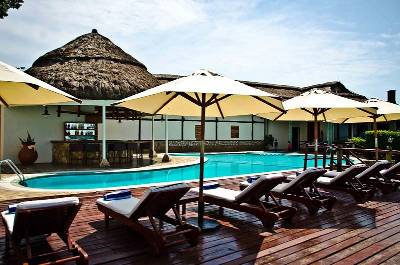
About Ugandan People
Over 80 per cent of the population live in rural areas and directly survive off the environment and natural resource base.
Population: Uganda’s population has continued to grow rapidly over time. It increased from 9.5 million in 1969 to 24.2 million in 2002. Between 1991 and 2002, the population growth rate was 3.2 percent. The population is projected to have increased to 32.9 million by mid-2011.
Religions: Christian, Muslim, others.
Languages: English (official), Swahili (official), Luganda, and numerous other local languages.
Ethnic groups: Baganda, Banyankole, Bahima, Bakiga, Banyoro, Batoro, Langi, Acholi, Lugbara, Karamojong, Basoga, Bagisu, and others. The Baganda are the largest ethnic group in Uganda and comprise approximately 17% of the population.
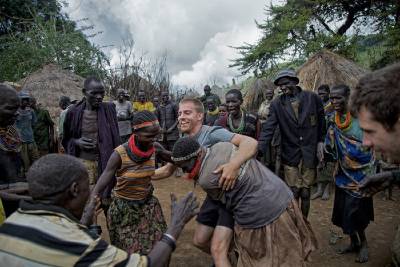
Climate
Uganda’s weather conditions are ideal, ranging from the warmth of the lowland areas to the coolness of the highlands in the South West Kigezi. For most of the year, Uganda is sunny with temperatures rarely rising above 29 degrees. The average temperature is about 26 degrees C, with a maximum of 18-31 degrees and minimum of 15-23 degrees depending on the part of the country. The rain season is March-May. Light rain season is November and December. Wet seasons are March –May and October-November; dry seasons are December to February and June to August.
Rainfall ranges between 500mm to 2500 mm and the relative humidity is 70 – 100%. The rainfall regime allows two planting and harvesting seasons a year in most parts of the country, without the use of irrigation. About 34% of the country is covered in wetlands with a dense network of rivers, lakes and swamps. Generally, the country is endowed with fertile soils. Uganda has some of the largest lakes on the continent including Lake Albert and Lake Victoria which can be encountered at Murchison falls national park
Where To go while on Uganda Safaris?
Murchison Falls National Park
Murchison Falls National Park is Uganda’s largest nature conservation area, located in North Western. It was first known as Kabalega and later changed to Murchison falls National after the grate falls passing through the park. It also inhabits a wide variety of mammals, birds and savannah woodland species.
Murchison Falls National Park lies at the northern end of the Albertine Rift Valley, where the sweeping Bunyoro escarpment tumbles into vast, palm-dotted savanna. First gazetted as a game reserve in 1926, it is Uganda’s largest and oldest conservation area, hosting 76 species of mammals and 451 birds.
The park is bisected by the Victoria Nile, which plunges 45m over the remnant rift valley wall, creating the dramatic Murchison Falls, the centerpiece of the park and the final event in an 80km stretch of rapids. The mighty cascade drains the last of the river’s energy, transforming it into a broad, placid stream that flows quietly across the rift valley floor into Lake Albert. This stretch of river provides one of Uganda’s most remarkable wildlife spectacles. Regular visitors to the riverbanks include elephants, giraffes and buffaloes; while hippos, Nile crocodiles and aquatic birds are permanent residents.
Notable visitors to the park include Winston Churchill, Theodore Roosevelt, Ernest Hemingway and several British royals. There are quiet of activities done while at the park which include game drives, Boat cruise, hiking to the top of the falls, birding, community visit, nature walks, sport fishing, chimpanzee trekking in Budongo forest.
Queen Elizabeth National Park
Queen Elizabeth National Park is one of Uganda’s oldest parks and the second largest park after Murchison Falls National Park. It first initially known as ‘Kazinga National Park’ before it was renamed to commemorate a visit by Queen Elizabeth II of Great Britain. It lies on the floor of Albertine rift valley.
Queen Elizabeth National Park is understandably Uganda’s most popular tourist destination. The park’s diverse ecosystems, which include sprawling savanna, shady, humid forests, sparkling lakes and fertile wetlands, make it the ideal habitat for classic big game, ten primate species including chimpanzees and over 600 species of birds.
Set against the backdrop of the jagged Rwenzori Mountains, the park’s magnificent vistas include dozens of enormous craters carved dramatically into rolling green hills, panoramic views of the Kazinga Channel with its banks lined with hippos, buffalo and elephants, and the endless Ishasha plains, whose fig trees hide lions ready to pounce on herds of unsuspecting Uganda kob.
As well as its outstanding wildlife attractions, Queen Elizabeth National Park has a fascinating cultural history. There are many opportunities for visitors to meet the local communities and enjoy storytelling, dance, music and more. The gazetting of the park has ensured the conservation of its ecosystems, which in turn benefits the surrounding communities.
Kidepo Valley National Park
Positioned at the open savanna plains of North eastern region of Uganda, Kidepo Valley National Park is one of the most isolated national park in Uganda but still stands out to be one of the best attractive places every wildlife viewer can ever visit in Uganda. The national park is undoubtedly among the best wilderness areas in Africa, harboring a couple of extinct species of wildlife that can’t be found in any other Ugandan national park.
Kidepo is right at the core of a Savannah landscape right next to a few mountains and water bodies. The reasons for planning your safari here are endless, something you will definitely see when you set foot on Uganda’s soil. Besides the exceptional wildlife safari experience, this national park is another great spot for a cultural trail especially to those who would like to see the Karamojong, Acholi plus other great tribes. Some of the other exciting tourism activities in the wilderness of this area include nature walks, birding and hiking.
Kidepo national park is a true gem with huge abundance in wildlife and also referred to as a hidden treasure of Uganda. It remains a true rendition of tourism in Uganda but remains unknown to many! Kidepo Valley National Park was gazetted into a national park in the year 1962 and currently hosts over 75 species of mammals and 470 species of birds. All these fall in a prime game viewing location.
This national park is situated in Kaabong district in Northeastern Uganda. By estimate, it is about 571 Kilometers by road form Kampala – Uganda’s capital and Moroto is apparently the largest town in the sub region. According to CNN Kidepo valley National park was named the 3rd best national park in Africa and visiting this national park will not only excite you but leaves a wonderful wildlife experience for a lifetime.
Bwindi Impenetrable National Park
Bwindi Impenetrable National Park is located in southwestern Uganda. The park is part of the Bwindi Impenetrable Forest home for the Mountain Gorillas and is situated along the Democratic Republic of Congo border next to the Virunga National Park and on the edge of the western Rift Valley. Bwindi is a true rain forest, and is also a UNESCO- designated World Heritage Site with one of the richest ecosystems in Africa and a diversity of animal and bird species.
The impenetrable forest is widely known for sheltering the highest number of mountain gorillas that give high number of travelers a chance to meet “face to face” with the critically endangered mountain gorillas in the jungle. More than half of the World’s mountain Gorilla population is resident in Bwindi with an estimated 420. Other activities that can be done while at Bwindi include; Community visits, nature walks, Batwa trail, bird watching.
Lake Mburo National Park
Lake Mburo National Park is the nearest from the capital city on an en-routes to western Uganda which has Uganda’s biggest number of attractions. It is the smallest of Uganda’s Savannah national parks with unique Precambrian metamorphic rocks which date back more than 500 million years. It was originally gazetted in 1933 as a controlled hunting area and upgraded to a game reserve in 1963. The Banyankole Bahima residents continued to graze their cattle in the reserve until it was upgraded to national park status in 1983.
Together with 13 other lakes in the area, Lake Mburo forms part of a 50km-long wetland system linked by a swamp known as Nakivali swamp sanctuary which habours a number of birds. Five of these lakes lie within the park’s borders. Lake Mburo National Park now contains much woodland as there are no elephants to tame the vegetation.
Activities done while in Lake Mburo include; game drive, boat cruise, birding, community visits, nature walks, biking, horse riding.
Kibale Forest National Park
Kibale national Park is also known as the primate capital of the World. Located in Western Uganda on an en route to Queen Elizabeth National Park. It is 766 square kilometers in size and is located between 1,100 meters to 1,600 meters in elevation. Approximately 350 km from the capital City Kampala. A habitat for a number of forest wildlife 70 mammals, most especially 13 species of primate coupled with chimpanzees. The park has varying vegetation from tropical forest cover, woodland, patches of grassland on the rift valley floor and swamp. It also contains over 375 species of birds, wild pig, forest elephants, duikers, buffalos, reptiles, amphibians and butterflies.
There are quite a number of activities done at Kibale National Park such as; Chimpanzee trekking, chimpanzee habituation, Hikes and Nature Walks ,nocturnal Forest walk, Bigodi Wetlands Sanctuary walk, Crater Lakes visit, Top of the World Hike were you have a glance at the beautiful scenery of all the crater lakes around the park.
Mgahinga National Park
The park lies in the Southern part of Uganda. The park derives its name from the word Gahinga meaning to protect. It was conserved to protect the rare mountain gorillas known as silver back and endangered golden monkeys which dominate the forests of the park. It is also Uganda’s smallest national Park.
The parks most exciting and eye catching features are its three conical, extinct volcanoes namely Mount Muhabura, Mount Gahinga, and Mount Sabyinyo. Part of the spectacular Virunga Range that lies along the border region of Uganda, Congo and Rwanda. Mgahinga forms part of the much larger Virunga Conservation Area which includes adjacent parks in these countries. Mgahinga is also a home for a number of birds.
The rich unique culture surrounding the park has made it stand out, for a number of years, Mgahinga’s dense forests were home to the indigenous Batwa also known as hunter-gatherers and fierce warriors who depended on the forest for shelter, food and medicine.
After gazetting and establishing the park, the Batwa were evicted from the forest and abandoned their low-impact, nomadic lifestyle. The only time they are permitted to re- enter their cherished forest is as tour guides on the Batwa Trail, on which visitors will discover the magic of the Batwa’s ancient home while enjoying nature walks and learning about the cultural heritage.
They showcase their ways of life in the forest, gather honey, point out medicinal plants and demonstrate how to make bamboo cups. Guests are invited to the sacred Garama Cave, once a refuge for the Batwa, where the women of the community perform a sorrowful song which echoes eerily around the depths of the dark cave, and leaves guests with a moving sense of the richness of this fading culture.
The major activities include; Gorilla Trekking in Mgahinga Park. A Gorilla Tour to Track the Nyakagezi Gorilla family, Bird Watching, Batwa Trail, Cultural encounters and nature walks.
Mt Elgon National Park
It is located in Eastern Uganda bordering Kenya. Mountain Elgon has the oldest and largest volcanic conical Base in East Africa with 4000sq.km. The park has a rich vegetation rich variety of vegetation ranging from montane forest to high open moorland. Over 300 species of birds, including the endangered Lammergeyer. Elephants and buffalo can be found on the lower slopes. The park is also home to a variety of small antelope and duiker, as well forest monkeys, including the black-and-white colobus and blue monkey.
Half of Uganda’s butterfly species have been reported in Mt. Elgon. The higher slopes are protected by national parks in Uganda and Kenya, creating an extensive trans-boundary conservation area which has been declared a UNESCO Man & Biosphere Reserve. Activities done while at Mount Elgon National Park include; Mountain climbing, Nature walks, Mountain Biking, Archery, Rock climbing to the Sipi falls, cave exploration and birding.
Mountain Rwenzori National Park
The Ruwenzori’s also known as Mountains of the Moon lies in western Uganda bordering Congo. It was designated a UNESCO World Heritage and Ramseur site. The park is covered with varying vegetation of equatorial snow peaks include the third highest point in Africa called Magherita peak, while the lower slopes are blanketed in moorland, bamboo and rich, moist montane forest. Huge tree-heathers and colorful mosses. It protects the highest parts of the 120km-long and 65km-wide Rwenzori mountain range.
The national park is a habitant for 70mammals which include the forest elephant, chimpanzee, black-and-white colobus, Lhotse’s monkeys, duiker, and 217 bird species including 19 Albertine Rift endemics, as well as some of the world’s rarest vegetation.
Semliki National Park
The park lies within the Great Rift Valley with lowland tropical rain forest. It is located in Bundibugyo Bwamba Sub County. It has diverse flora and fauna. It is a habitant for more than 400 birds, over 60 mammal species, including forest buffalos, leopards, hippos, monkeys, water chevrotains, bush babies, civets, elephants, and the pygmy flying squirrel. Nine species of duikers are found in the park, including the bay duiker. The park has eight primate species and almost 300 butterfly species. The rich culture surrounding the park which consists of the Bambuti Pygmies who live on both side of the Semliki River and are closely related to the Basu Pygmies of the Democratic Republic of the Congo rather than to Batwa Pygmies around Bwindi Impenetrable Forest and Mgahinga Gorilla Park.



